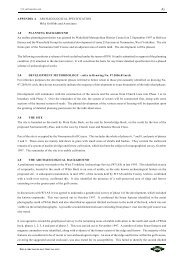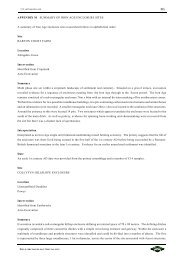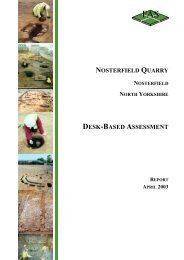ARCHAEOLOGICAL EVALUATION - Mike Griffiths and Associates
ARCHAEOLOGICAL EVALUATION - Mike Griffiths and Associates
ARCHAEOLOGICAL EVALUATION - Mike Griffiths and Associates
You also want an ePaper? Increase the reach of your titles
YUMPU automatically turns print PDFs into web optimized ePapers that Google loves.
FAS_lbf01.wpd 166<br />
origin (Figure 107).<br />
9.0 DISCUSSION<br />
The results of the staged evaluation programme at Ladybridge Farm allow a number of conclusions to be drawn<br />
regarding the nature of archaeological features within this area. The battery of techniques used has proved to<br />
be complementary <strong>and</strong> results suggest a general dearth of archaeological remains at the site. Indeed, there is<br />
little by way of archaeological remains for most periods, particularly from the Bronze Age to the modern period.<br />
The results do, however, point to an area of prehistoric activity in the southern part of the site, focussed towards<br />
the highest ground in the southwest corner of the area of investigation (Zone C). This can be interpreted as part<br />
of a wider area of Neolithic activity, located on l<strong>and</strong> surrounding an in-filled lake, the relict bank of which was<br />
identified in Zone E.<br />
9.1 CROPMARKS AND HISTORIC FIELD BOUNDARIES<br />
The linear <strong>and</strong> curvilinear features identified from aerial photography were largely targeted by trial trenches <strong>and</strong><br />
proved to be of no archaeological interest. All of the cropmarks identified within the area of investigation,<br />
including the concentric of features to the west of Ladybridge Farm, seem likely to be either geological in origin,<br />
reflect surface topography, or represent temporary paths into the farml<strong>and</strong>.<br />
9.2 GEOPHYSICAL SURVEY<br />
Of the thirty-five evaluation excavation trenches, fifteen were positioned specifically to investigate anomalies,<br />
or intersect possible linear features, detected by geophysical survey. Of these, twelve were designed to target<br />
features identified within the magnetometer data (Interventions 17, 18, 23, 26, 27, 29, 30, 32, 33, 34, 36 <strong>and</strong> 38)<br />
<strong>and</strong> seven trenches were located to investigate anomalies identified by soil resistance survey (Interventions 8,<br />
9, 13, 29, 30, 33 <strong>and</strong> 34). In some cases a trench was designed to encounter both kinds of anomaly as well as<br />
cropmarks. With the exception of seven sinkhole features <strong>and</strong> two undated pits the features identified in the<br />
geophysical data were not encountered archaeologically. In addition several areas of magnetic variation or high<br />
<strong>and</strong> low resistance were confirmed as variation in the underlying natural subsoil. The modern agricultural pit<br />
encountered at the easternmost end of Intervention 13 was detected during soil resistance survey.<br />
The magnetometer survey proved successful in identifying the location <strong>and</strong> distribution of sink hole features<br />
due to subsequent subsiding fills containing more dished ploughsoil, which was more magnetic than the<br />
surrounding natural subsoil. In addition the features tended to have higher moisture levels than the surrounding<br />
s<strong>and</strong> <strong>and</strong> gravel <strong>and</strong> were therefore also susceptible to detection through soil resistance survey. Other than these<br />
large features the geophysics proved capable of locating modern field drains <strong>and</strong> ploughing but little by way of<br />
archaeological significance.<br />
93. FIELDWALKING AND TEST PIT EXCAVATION<br />
Fieldwalking <strong>and</strong> test pit excavation finds were dominated by late post-medieval <strong>and</strong> modern material derived<br />
FIELD ARCHAEOLOGY SPECIALISTS







